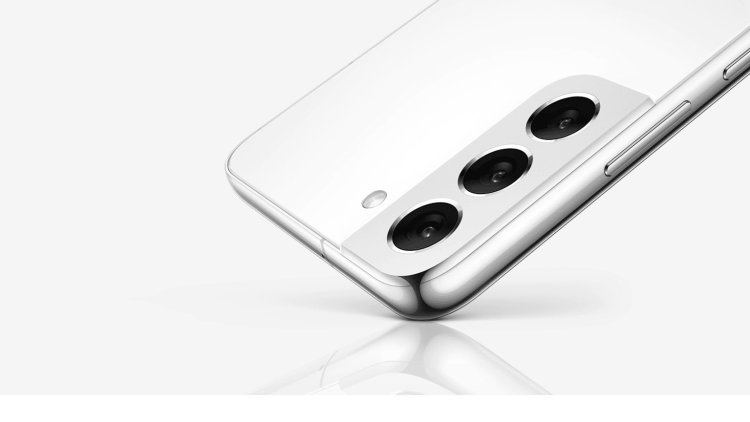This year's Samsung Galaxy S22 line is unique

This year's Samsung Galaxy S22 lineup is one-of-a-kind.
In it, the Galaxy S and Galaxy Note families were merged in the Ultra model. But just in it, because the Galaxy S22 + is a direct successor to last year's model, the Galaxy S21 +, and has a striking cosmetic resemblance. Under the hood and in the software, changes have occurred.
The Samsung Galaxy S22 + arrived in a little container that contained almost nothing - aside from the phone and the cable, there were only some papers and links to unlock the nanoSIM slot. Pink Gold, which is nominally pink but has a hint of gold. There are additional models available, with some color choices only accessible on the manufacturer's website.
Aside from that, the phone is really lovely and well-made. Gold, shiny metal frames with rounded edges blend smoothly with the frosted glass on the back panel and the matte metal island covering three lenses - next to it is an LED hole.
The front touch panel is flat and constructed of Gorilla Glass Victus glass, while the screen has a very tiny frame and a hole to cover the front camera. Surprisingly, the proximity and illumination sensors were most likely positioned under the screen, but it is impossible to tell where they are because no traces can be seen even when the panel is heavily illuminated.

The overall layout is traditional for Samsung, with a nanoSIM socket cap, a USB-C socket, and a loudspeaker (the other is in the gap between the top of the screen and the frame) at the bottom, and buttons for unlocking and connecting the volume on the right.
The phone boasts a 6.6-inch screen and dimensions that allow it to fit perfectly in hand – but it could be a little less slippery.
Samsung Galaxy S22 + parameters
Processor Samsung Exynos 2200, 4 nm, Octa-core (1 x 2.8 GHz Cortex X2 & 3 x 2.50 GHz Cortex-A710 & 4 x 1.8 GHz Cortex-A510) GPU Xclipse 920 Screen 6.6 ", 1080 x 2340 px, 19.5: 9, 393 ppi, Dynamic AMOLED 2X, 10-120 Hz, HDR10 +, 1750 nit (peak), 88.3% StB RAM 8 GB Flash memory 128 GB (256 GB versions also available) UFS 3.1 Main camera - 50 Mpix, f / 1.8, 23 mm (wide), 1 / 1.56 ", 1.0 µm, Dual Pixel PDAF, OIS
- 10 Mpix, f / 2.4, 70 mm (telephoto), 1 / 3.94 ", 1.0 µm, PDAF, OIS
- 12 Mpix, f / 2.2, 13 mm, 120˚ (ultra wide), 1 / 2.55" 1.4 µmFront camera 10 Mpix, f / 2.2, 26 mm (wide), 1 / 3.24 ", 1.22 µm, Dual Pixel PDAF Audio stereo, Hi-Res Audio 32-bit / 384 kHz Communication 5G, LTE +, HSPA, Wi-Fi 6e, Bluetooth 5.2, NFC, Ultra Wideband, dual SIM / eSIM / USB-C 3.2 location A-GPS, GLONASS, GALILEO, BDS Battery Li-Ion 4500 mAh, USB-PD 3.0 charging 45 W, Fast Qi / PMA 15 W, wireless reverse charging 4.5 W Libra 195 g Sizes 157.4 x 75.8 x 7.6 mm Certificates IP68 Operating system Android 12 with One UI 4.1 and support for DeX / Wireless DeX mode
Display
The Samsung Galaxy S22 + features a Dynamic AMOLED 2X screen with a resolution of 1080 x 2340 pixels and a diagonal of 6.6 inches, resulting in a density of 393 PPI, which is sufficient for a smooth, high-quality image. The screen can work with a conventional refresh rate of 60 Hz or an adjustable refresh rate of 48-120 Hz.
The panel can be adjusted in the 48-120 Hz range, whereas the software in the Galaxy S22 + can transfer the image slower, with a frequency reduced down to 10 Hz, reducing energy consumption, albeit to a lesser extent.
According to the manufacturer, the maximum screen brightness is 1750 nit. You should be aware that this only applies to HDR mode and that it is only a transient value for tiny areas of the image.
The maximum continuous brightness in static mode is around 500 nit, or 800 nits after enabling the "increased brightness" option in the options. When we leave the brightness adjustment to the machine, the maximum value of the backlight can reach 1200 nits.
Color reproduction has always been superb for Samsung. The natural mode is compatible with the sRGB color space, as well as the vivid DCI-P3 and, comparable to the Galaxy S21.
There is a blue component reduction (blue light filter), and there is an Always-on Display with multiple adjustable modes, including light and dark mode. It is fully compatible with popular video-on-demand (VOD) and high-definition (HDR) providers.
In terms of the latter, it is only strange to explain the lack of Dolby Vision support - the equipment is obviously not an impediment here, but Samsung supplies "only" HDR10, HDR10 Plus, and HLG. In any event, the film displayed on the Galaxy S22 + screen looks fantastic, and anyone who enjoys watching movies on a smartphone screen will not be disappointed.
System
The Samsung Galaxy S22 Plus is powered by Android 12 and the One UI 4.1 overlay. It should be stressed that it works quite well.
Whoever likes it can personalize the look by changing not only the wallpaper but also other components of the "decor" - either on their own or by using ready-made themes accessible in the store. The fast access bar shows on the right side of the screen by default.
As befitting a top-tier smartphone, the Samsung Galaxy S22 + supports DeX mode. When connected to an external display via a DP Alternate cable or wireless, Miracast compatible, or by connecting to a computer via the appropriate application, this is possible.
Communication
The Samsung Galaxy S22 + features a 5G modem, LTE Plus (with band aggregation), and WiFi 6e.
The quality of network connections was superb - the Galaxy S22 + supports the EVS / HD Voice + codec in the Super Wideband version, and you can hear it.
Also includes two nanoSIM card slots as well as eSIM support.
The Samsung Galaxy S22 + has Bluetooth 5.2 and NFC, as well as the ability to pay with Google Pay and HCE. Locating systems like A-GPS, GLONASS, BDS, and GALILEO are employed.
Performance
The theme of performance in the Galaxy S22 + is the next installment of the saga of good versus evil, Amber versus Chaos, Rebellion versus the Empire, Gondor versus Mordor, and, in fact, Snapdragon versus Exynos.
In Europe, Samsung consistently offers a version with its own processor, Qualcomm's SoC, while reserving it for the rest of the world. Complaints about this situation are common because the grass is always greener on the other side.
The strength of the GPU in 3D graphics applications - the Exynos 2200 finally acquired, instead of the previous Mali GPU, a completely new graphics unit Xclipse 920, built by AMD and based on the highly popular RDNA2 architecture.
And the results show it: the Exynos 2200 easily outperforms both its predecessor, the Exynos 2100, and its main competition, Snapdragon, in 3DMark testing. Only the iPhone 13 Pro easily outperforms it.
But that is not a predetermined conclusion - RDNA2 in mobile devices is a debutant, and - as with AMD systems - a lot may be modified by refined drivers.
The stress test was not ideal.
The Samsung Galaxy S22 + achieved results of 2073 and 1238 points, respectively, and stability of 59.7 percent. Thermal throttling is therefore obvious, but not rare - it is worth mentioning that the lowest result is comparable to Snapdragon, and the greater difference is attributable to the higher performance "cold."
Interestingly, the S22 + slowed down quite slowly in consecutive snowstorms, so we are unlikely to be in a situation where the phone starts cutting drastically under stress with normal use. And the phone hasn't warmed up sufficiently to be considered unusable.

Audio
The stereo speakers of the Samsung Galaxy S22 Plus are built on the basis of AKG solutions. One speaker is located on the smartphone's short edge close to the USB-C connector, while the other is located between the screen and the opposite side and is utilized for both calls and entertainment.
Unfortunately, the characteristics and volume of both drivers are absolutely different - just cover one of them with your finger to hear the change. As a result, the stereo panorama is moved, and the sound quality is only adequate, despite the fact that the high and low tones are pretty adequately reproduced for a smartphone.
Because the Galaxy S22 + lacks a mini-jack output, attaching cable headphones necessitates the use of an adapter, which Samsung does not include in the package.
On paper, it appears to be fairly impressive; the converter supports Hi-Res Audio 32/384, and the software has the ability to tailor the operation to the demands of users of various ages, as well as a UHQ scaler.
Power
The Samsung Galaxy S22 Plus has a built-in Li-Ion battery with a capacity of 4500 mAh, which is 300 mAh… less than the previous year's model. Yes, the CPU is produced in a more cost-effective technological dimension, but if you expect the Galaxy S22 + to not shatter working time records, you are correct. In the 3DMark Battery test, it received a score of 9 hours and 7 minutes.
Photography
The Samsung Galaxy S22 + has three cameras in a fairly typical configuration:
- 50 Mpix, f / 1.8, 23mm (wide), 1 / 1.56 ", 1.0 µm, Dual Pixel PDAF, OIS
- 10MP, f / 2.4, 70mm (telephoto), 1 / 3.94 ", 1.0 µm, PDAF, OIS
- 12 Mpix, f / 2.2, 13mm, 120˚ (ultra wide), 1 / 2.55 ”1.4 µm
So we have a simple wide-angle camera with a lens with an equivalent focal length of 23 mm FF and a big Tetracell matrix. The camera features an excellent and quick Dual Pixel AF system that uses phase-detection and is optically stabilized. The produced files are 12 Mpix in size.
The telephoto lens appears to be considerably more modest. The 10 Mpix matrix works with glass with an f / 2.4 brightness and an equivalent focal length of FF 70 mm, making it ideal for portraits. Again, AF is based on phase detection, but this time with separated pixels. Optical Image Stabilization is also available (OIS). The generated files have been scaled to 12 Mpix.
The ultra-wide-angle lens appears to be the same as in last year's models, therefore it lacks both stabilization and autofocus. The corresponding focal length is 13 mm, and the lens brightness is f / 2.2.
The Samsung Galaxy S22 + can handle x10 close-ups, producing images of unexpectedly high quality. The photographs are already quite ordinary for the x20 setting, but they can be regarded as useful. Higher magnifications (the range ends at x30) are only a curiosity, but they do not detract from Samsung's overall positive impression.
Without the night mode, the photo quality is ordinary to poor, with a lot of noise in parts unless the scene is extremely well lighted with artificial light. The night mode (whether enabled manually or automatically) produces images of very good quality for the main camera and acceptable or good quality for the others, except when there is very little light, in which case the number of artifacts considerably increases.
In terms of video capabilities, the Galaxy S21 + can record in 4K mode at 60 frames per second or 8K at 24 frames per second (it is required to turn on the HEVC codec in the settings). The option of recording in HDR10 + mode is currently available for testing.
Summary
The Samsung Galaxy S22 Plus is an excellent smartphone from the top tier. Although it is not the best-equipped model in the series, its capabilities are excellent, and the limitations, while present, do not detract from the smartphone's overall good rating.
Given the manufacturer's long-term support, we can confidently declare that it is one of the most secure options in the top pricing range.





























